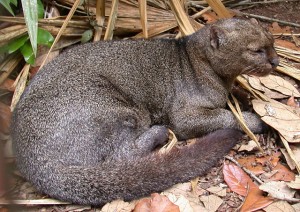- Home
- Accommodation
- Activities
- Area Info
- Maps
- Photo Galleries
- Real Estate
- Travel
Jaguarundi
Spanish Name: Gato Maro
Height Weight: An adult generally has a head and body length of 0.76 to 0.82 m, and a tail 0.32 to 0.506 m long. They weigh about 9 kg.
Found In: This cat can survive in variety of habitats, including tropical evergreen forest, and dry deciduous forests. In Costa Rica at Corcovado National Park, Santa Rosa National Park, Monteverde Cloud Forest Reserve, San Jose and also in La Selva and San Vito.
Life Span: About 15 years
 The jaguarundi is slightly quirky in its appearance compared to other felines, in the sense that it looks more like a weasel. They have slender, lengthy bodies, short legs, a small flattened head, elongated tail, and a smooth, unmarked coat. Adults can weigh as little as 6 pounds or as much as 20. They are 10-14 inches in height until the shoulder, and reach a length of 35-55 inches.
The jaguarundi is slightly quirky in its appearance compared to other felines, in the sense that it looks more like a weasel. They have slender, lengthy bodies, short legs, a small flattened head, elongated tail, and a smooth, unmarked coat. Adults can weigh as little as 6 pounds or as much as 20. They are 10-14 inches in height until the shoulder, and reach a length of 35-55 inches.
The jaguarundi is mostly found in the bushy areas of the low land region. They are also known to inhabit areas near water bodies like rivers and streams. At times they can be spotted on elevations up to 3200m. They are extremely adept climbers and are mostly on land for the purpose of hunting. They can be spotted in the National Parks of Costa Rica like Corcovado National Park, Monteverde Cloud Forest Reserve, Santa Rosa National Park, Santa Elena Cloud Forest Reserve, and San Jose. They can also be found in Sirena Biological Station, San Vito and La Selva.
Unlike most big cats in Costa Rica and the Montezuma Beach area, the Jaguarundi is very diurnal, and possesses a round pupil. Its face looks menacing compared to other cats because of its unusual eyes, weird body proportion, and dark coat color. It is a medium-sized cat with a more athletic slim body frame and relatively long neck and head. Unlike other small cats in Central America, the jaguarondi isn’t of the spotted variety, but features a solid black, charcoal, or reddish hue. This big cat is also unusual for its family because it is more likely to get aggressive when confronted, while other cats tend to avoid confrontation.
Jaguarundis are day animals and differ in that sense to other more nocturnal new world felines. They can be spotted moving throughout the day and retreating at night, so there’s a good chance for Montezuma visitors to spot them in the early hours of the day during the wildlife safaris. These creatures are also known to be innately territorial in nature compared to other Costa Rican big cats. There are constant fights among themselves for protection of their individual territories. These cats are extremely active throughout the day and can be been climbing trees and moving about in the early mornings and late noon.
In Costa Rica, jaguarondis were known to be comparatively easy to tame by the early natives. They came handy in keeping a check on the rodent population. They aren’t very popular as pets today. They are known to have a huge variety of vocal sounds, with researchers having documented at least 13 different calls.
Jaguarundis enjoy a varied diet comprising rodents, rabbits, armadillos, quail, turkey, reptiles, frogs, and poultry. They aren’t known to be very fussy eaters and will sometimes also feed on fish caught in the middle of puddles.
After a gestation period of approximately 70-75 days, females produce a litter of 1-4 kittens. Like lions, the jaguarundi kittens are born spotted, which disappear in a few days. They start their solid food intake around the age of 6 weeks, and attain sexual maturity between 24-36 months. The female will have a couple or more young ones at a time a hollow space, or thicket.
Although the jaguarundi rests and hunts on the ground, it is a dexterous climber. This cat can be spotted in and around the Montezuma region in the early morning and late afternoon, near dense bushes and water bodies. The feline can also be spotted in and around community settlements, since it is known to eat chickens. Despite this and its daylight prowling, the jaguarondi is still a stealthy by nature, not very commonly spotted and careful of not being caught.
Jaguarundis are not known to be very social. They will often move about and forage solitary or in pairs such a mother with her offspring.
Jaguarundis are not usually exploited for trade though like many other felines they are seen as exotic pets and valuable species. Habitat destruction and encroachment presents greater threat to their population. Since they are seen as a nuisance for eating poultry livestock, jaguarundis are also under threat from local farmers.
Further Reading
http://bigcatrescue.org/jaguarundi-facts/
Wikipedia’s – article about the Jaguarundi
Jaguarundi Nat’l Wildlife Refuge
Great Stuff

Clandestina Restaurant
My new favorite restaurant, Clandestina is not to be missed by food lovers staying anywhere near to Montezuma. Established in March 2015, Clandestina is the new kid on the block. The Oregon/Tico collaboration is a winner among locals and travelers alike, with artisan craft beers, made onsite by Butterfly Brewing Co. and delicious, exciting […]











